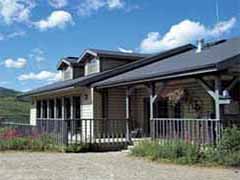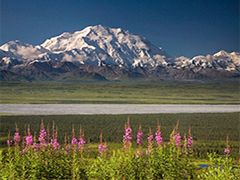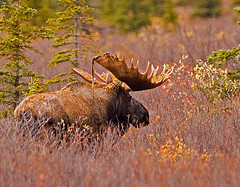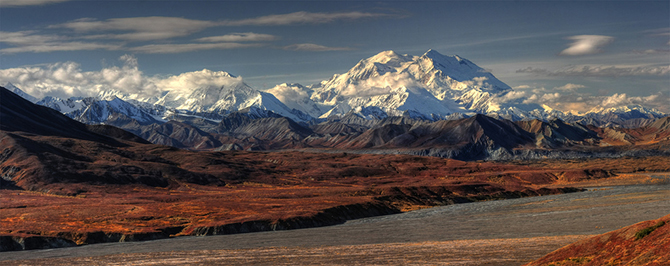FAQ | Denali National Park | formerly Mt.McKinley National Park
| |
Q:
A: |
How can I find Denali National Park?
The Park is located on the George Parks Highway - 120 Miles south of Fairbanks and 240 Miles north of Anchorage. There are only a few smaller communities such as Talkeetna, Cantwell and Nenana between these two major cities and therefore the Park area is somewhat isolated. Denali National Park is an integral highlight in our curated driving tour packages and Alaska railroad vacations. Whether by road or rail/road combo tour, discover the breathtaking beauty of Alaska with seamless itineraries that make every moment unforgettable. |
|
| |
Q:
A: |
What is so special about Denali National Park?
Denali National Park is renowned for its breathtaking natural beauty and unique features that make it truly special. The park's most iconic feature is Denali itself, formerly known as Mount McKinley, which is North America's highest peak, towering at 20,310 feet (6,194 meters). This majestic mountain attracts climbers, adventurers, and nature enthusiasts from around the world.
Denali National Park is a wilderness wonderland, encompassing over six million acres of pristine landscapes, including taiga forests, tundra, and glaciers. It is home to a diverse range of wildlife, including grizzly bears, moose, caribou, wolves, Dall sheep, and a variety of bird species. Visitors have the chance to witness these animals in their natural habitat.
What makes Denali particularly special is its commitment to preserving wilderness and minimizing human impact. Most of the park's interior is accessible only by a single, 92-mile (148-kilometer) road, restricted to park buses, private vehicles are not allowed. This limited access helps protect the environment and ensures that visitors can experience a relatively undisturbed wilderness.
In Denali, you can enjoy outdoor activities like hiking, wildlife viewing, and camping in one of the most unspoiled and awe-inspiring natural settings on the planet. Its majestic landscapes, diverse wildlife, and dedication to conservation make Denali National Park a unique and remarkable destination for nature enthusiasts and adventurers alike. |
|
| |
Q:
A: |
How do I get to Denali?
The national park area is easily accessible via the paved George Parks Highway or with the Railroad.
Railroad
Denali Star & the Midnight Sun Express | Daily departures from / to Anchorage, Talkeetna and Fairbanks. Check out our railroad packages from Anchorage, Seward and Fairbanks
Bus and Van Service
Daily departures from Anchorage, Seward, Whittier and Fairbanks
Car
Rent a car, van, or 4x4 in Anchorage and drive to Denali National Park. One-way rentals are available between Anchorage, Fairbanks and Seward. Our driving tours include the rental car, accommodation and activities at Denali Park. |
|
| |
Q:
A: |
Can I drive into the National Park?
Private vehicles are not allowed beyond the Savage Creek Ranger Check Station at Mile 15 of the Park Road – except with a permit. Therefore the National Park Service offers a shuttle bus system from approximately end of May until the middle of September (depends on weather conditions) between the Visitor Center and Wonder Lake, at the end of the 90 Mile long Road. The busses are departing from 6:00 am onwards about every 1/2 hour. Passengers have the opportunity to get on and off the bus at any point along the park road for hikes and wildlife viewing. This allows visitors to explore the park at their own pace and leisure. Note: Advance reservations for the shuttle busses (also called transit bus) are absolutely necessary. If you arrive without shuttle bus reservations you may have to wait one or two days in order to get a ticket. Our tour packages already include the shuttle bus into the park. This way you definitely won't miss this unforgettable adventure!
Update: The Denali Park Road … 2023 season and beyond
The Denali Park road has been deteriorating at an accelerated pace the past two years and is now being rebuilt, primarily in one section at Polychrome Pass, in 2022 through 2026. Access will be restricted beyond Mile 43 for the oncoming tour seasons. It is important to note that the park is not “closed” and that visitors will still be able to experience Denali National Park during the next few years. The “Tundra Wilderness Tour” and Denali Transit Buses will be traveling to mile 43. Road construction is shortening the guest experience only by about 10 miles of the historical Tundra Wilderness Tour. Unfortunately guests will not be able to visit Polychrome Pass, Eielson Visitor Center and Kantishna Roadhouse. |
|
| |
Q:
A: |
How long will it take to visit the Park?
The shuttle bus service offers a number of well worth visiting destinations.
Savage River | this is the farthest point (15 Miles from park entrance) visitors can travel in their own vehicle on the park road. At this point there is a small parking area, picnic tables, and the trailhead for the Savage River Trail (about 2 Miles) Visitors can make use of the free Savage River Shuttle that runs regularly between the entrance area and the Savage River. The Savage River Campground is located at Mile 13 and Savage campers with tickets can be picked up at the bus stop for the shuttle into the park.
Sanctuary River | 23 Miles from the park entrance provides an established campground and a park ranger station. There are seven sites for tent camping and access is by bus. Campers with tickets may use the Park Shuttle system, and great hiking is available in the vicinity of Sanctuary campground.
The Teklanika River | 30 Miles from the park entrance runs through Igloo Forest, creating large gravel bars for easy travel. A rest stop at Teklanika provides restrooms, and expansive views from the deck. Campgrounds are nearby at Teklanika and Igloo Creek campgrounds.
Polychrome Pass & Rest Area | 46 Miles from the park entrance offers a spectacular view of the colorful Alaska Range. The Polychrome Glaciers are nestled in the hills to the south, while bears and caribou often wander on the river bars below. For a day hike, walk along the ridge behind the rest area and enjoy alpine scenery. Buses run as far as Polychrome from June to August.
Toklat | at Mile 53 is a 6-hour round trip. Toklat River is an area of braided glacial rivers and towering cliffs where Dall sheep are often seen. Grizzlies sometimes graze on the riverbed’s soapberries. Buses run as far as Toklat from late May through Mid-Sept weather permitting.
Fish Creek | a trip to the newly build Fish Creek Visitor Center, at Mile 66 takes about 8-hours (round trip) and is the closest location for scenic views of towering Mt. McKinley.
Wonder Lake | at Mile 85 is an 11-hour round trip. The beautiful lake offers a picture perfect view of Mt. McKinley. Along the road to Wonder Lake, alder and willow-carpeted hills are dotted with kettle ponds. Look for beaver along the way, and be sure to keep an eye out for blueberries in late summer and fall. Buses run to Wonder Lake June 8 through Mid-September weather permitting
Kantishna | at Mile 90 is about a 13-hour round trip. The gold mining area is primarily a destination for backpackers heading for the national parks backcountry sections or for clients who are staying at various remote backcountry lodges in the viciity of Kantishna. One Bus travels to Kantishna between June 8 and September 11. Kantishna is primarily a destination for lodge visitors and backpackers headed for the backcountry. Please respect the private lands you may encounter in this area. |
|
| |
Q:
A: |
What about Sightseeing within Denali National Park?
Denali National Park and Preserve is famous for North America's highest mountain peak - 20,320-foot tall Mount Denali (formerly Mt. McKinley), spectacular landscapes, rugged mountain peaks and abundant wildlife. More than 6 million acres encompass a complete sub-arctic eco-system. |
|
| |
Q:
A: |
What about Wildlife Viewing?
Denali National Park is home to a variety of wildlife. Moose, Grizzly Bears, Caribous, Dall Sheeps, Wolves, Foxes, Golden Eagles, Beavers, and a multitude of migratory birds and waterfowl are plentiful throughout the park. Moose and Grizzly Bear sights are possible and rather common even within the improved sections of the park. |
|
| |
Q:
A: |
Will I see Mt. Denali?
The more time you spend inside the park, the better are your chances to see Mt. Denali. The entire mountain is visible only on a few days during each summer, however you may be fortunate to get a view of Mt. Denali or some of the other mountain peaks and glaciers of the Alaska range during your stay. Even when the clouds obscure your view of the mountain from ground level, you can frequently see it while on a hike that gains elevation, or on a flight seeing trip. |
|
| |
Q:
A: |
Are any hotels directly in the Park?
Only a very limited number of remote wilderness lodges are operating within the national park boundaries. Please check our page: Denali Wilderness Lodges. Most hotels are located at Denali Village – along the Parks Highway – one Mile from the visitor center. |
|
| |
Q:
A: |
Can I buy beverages or food in the Park?
There is no food or beverage service available on either the busses or anywhere past Mile 2 of the park road. Please plan ahead and bring your own snacks, lunch, and beverages. Restrooms are available at approximate one-hour intervals along the park road. Water bottles can be refilled at Eielson Visitor Center. |
|
| |
Q:
A: |
Which services are available near the Park?
Within a few miles of the Park entrance there are lodges, restaurants, gift shops, gas stations, small convenience stores, and various other visitor related services. |
|
| |
Q:
A: |
What’s about other activities?
There are a number of outfitters and soft-adventure companies operating near the park boundaries. Some of the activities include: flight seeing adventures, helicopter flights, rafting, float trips, sled dog tours, evening dinner theater. Please refer also to our individual sightseeing pages. |
|
| |
Q:
A: |
How is the weather?
Weather in Denali is extremely variable. Many of the rangers tell visitors to expect sun, wind, rain, clouds and even snow - sometimes all on the same day. Temperature can range from the mid 20's in early May and September to 85 degrees in July. Normal temperatures are in the high 60's with nights cooling off to between 40 and 50 degrees. Wearing layers of clothing makes it easy to regulate your body temperature. Also, you'll find that a good waterproof raincoat is invaluable. It will be daylight for 24-hours a day throughout May, June and the first half of July. |
|




